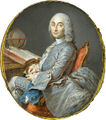Template:Selected anniversaries/June 17: Difference between revisions
No edit summary |
No edit summary |
||
| (3 intermediate revisions by the same user not shown) | |||
| Line 25: | Line 25: | ||
||1901: The College Board introduces its first standardized test, the forerunner to the SAT. | ||1901: The College Board introduces its first standardized test, the forerunner to the SAT. | ||
||1902: Harry Nelson Pillsbury dies ... chess player. Pic. | |||
||1902: Hubert Schardin Hermann Reinhold born ... ballistics expert, engineer and academic who studied in the field of high-speed photography and cinematography. Pic. | ||1902: Hubert Schardin Hermann Reinhold born ... ballistics expert, engineer and academic who studied in the field of high-speed photography and cinematography. Pic. | ||
| Line 31: | Line 33: | ||
||1906: Samuel S. Wilks born ... American mathematician and academic who played an important role in the development of mathematical statistics, especially in regard to practical applications. During World War II he was a consultant with the Office of Naval Research. Both during and after the War he had a profound impact on the application of statistical methods to all aspects of military planning. Pic search yes: https://www.google.com/search?q=samuel+s.+wilks | ||1906: Samuel S. Wilks born ... American mathematician and academic who played an important role in the development of mathematical statistics, especially in regard to practical applications. During World War II he was a consultant with the Office of Naval Research. Both during and after the War he had a profound impact on the application of statistical methods to all aspects of military planning. Pic search yes: https://www.google.com/search?q=samuel+s.+wilks | ||
||1911: Hans Maass born ... mathematician who introduced Maass wave forms, the Koecher–Maass series and Maass–Selberg relations, and who proved most of the Saito–Kurokawa conjecture. Pic. | ||1911: Hans Maass born ... mathematician who introduced Maass wave forms, the Koecher–Maass series and Maass–Selberg relations, and who proved most of the Saito–Kurokawa conjecture. Pic. | ||
| Line 41: | Line 41: | ||
File:Bonus marchers.gif|link=Bonus Army (nonfiction)|1932: [[Bonus Army (nonfiction)|Bonus Army]]: Around a thousand World War I veterans amass at the United States Capitol as the U.S. Senate considers a bill that would give them certain benefits. | File:Bonus marchers.gif|link=Bonus Army (nonfiction)|1932: [[Bonus Army (nonfiction)|Bonus Army]]: Around a thousand World War I veterans amass at the United States Capitol as the U.S. Senate considers a bill that would give them certain benefits. | ||
||1940: Arthur Harden dies ... biochemist and academic, Nobel Prize laureate. Pic. | ||1940: Arthur Harden dies ... biochemist and academic, Nobel Prize laureate. Pic. | ||
| Line 71: | Line 69: | ||
|O’Meara Alt spelling | |O’Meara Alt spelling | ||
File: | File:Self portrait (17 June 2022) 20220617 072846.jpg|link=Self portrait (17 June 2022)|2022: '''[[Self portrait (17 June 2022)|Self portrait]]'''. | ||
</gallery> | </gallery> | ||
Latest revision as of 08:30, 17 June 2024
1714: Astronomer and cartographer César-François Cassini de Thury born. In 1744, he will begin the construction of a great topographical map of France, one of the landmarks in the history of cartography. Completed by his son Jean-Dominique, Cassini IV and published by the Académie des Sciences from 1744 to 1793, its 180 plates will be known as the Cassini map.
1832: Chemist and physicist William Crookes born. Crookes will be a pioneer of vacuum tube technology, developing the partially evacuated Crookes tube circa 1869-1875.
1925: Pharmacologist and chemist Alexander Shulgin born. He will discover, synthesize, and personally bioassay over 230 psychoactive compounds for their psychedelic and entactogenic potential.
1932: Bonus Army: Around a thousand World War I veterans amass at the United States Capitol as the U.S. Senate considers a bill that would give them certain benefits.
1972: Watergate scandal (nonfiction): Five White House operatives are arrested for burgling the offices of the Democratic National Committee, in an attempt by some members of the Republican party to illegally wiretap the opposition.
2022: Self portrait.





